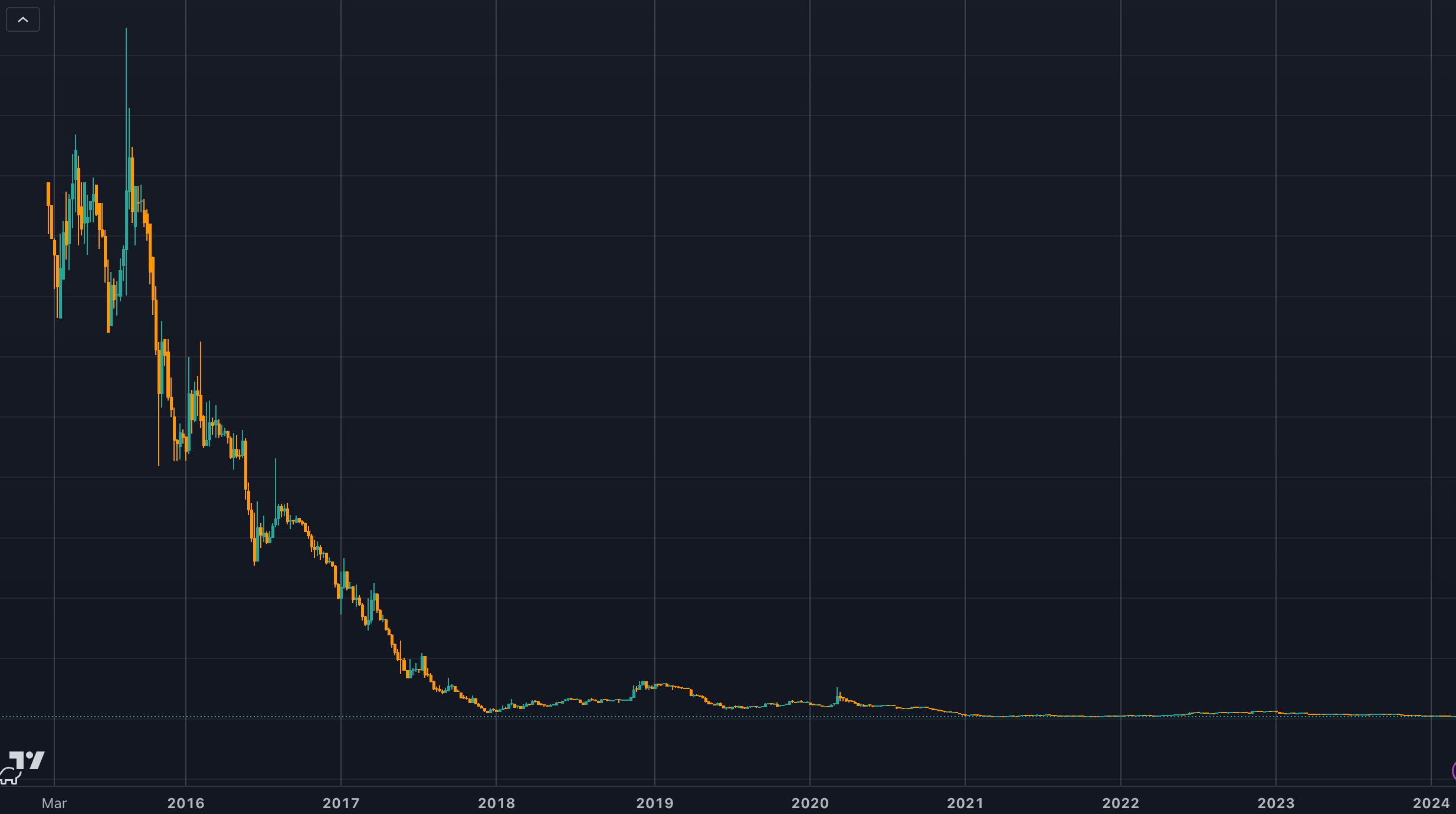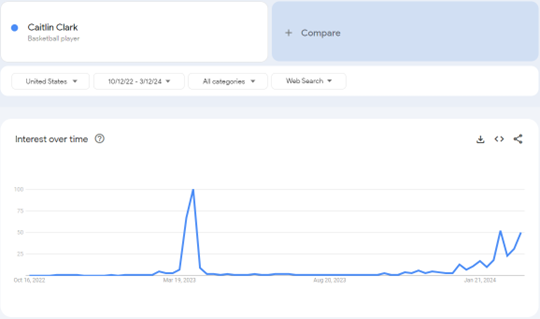Uncategorized
100 sats would equal $1 if we repeat last cycle’s dollar demise
The inverse of the standard BTC/USD chart gives an interesting perspective on the rise in the purchasing power of Bitcoin over time. The USDT/BTC chart…

The inverse of the standard BTC/USD chart gives an interesting perspective on the rise in the purchasing power of Bitcoin over time. The USDT/BTC chart below highlights the dollar’s decline against Bitcoin since 2015. From its peak, the dollar has fallen 99.7% against Bitcoin.
When viewed in this form, it’s hard to be bearish on a 13% dip from a new all-time high.
When we look at the chart over a shorter timeframe in a log format, we can better analyze recent data. Since the COVID-19 crash of May 2020, the dollar has fallen 96% against Bitcoin. Currently, $1 equals around 1,580 satoshis (sats.) A further fall of just 36% would bring us to 1,000 per dollar.
Moreover, for 100 sats to equal $1, the dollar would only need to fall another 93.6%, less than the move last cycle. This would make 1 cent akin to 1 sat, bringing nominal parity between Bitcoin and the dollar in unit terms. The Bitcoin to USD increase would be approximately 1,500% to $1 million.

Finally, 10 sats per dollar would require a 99.4% decline, and 1 sat per dollar would total up to 100%. Bitcoin cannot be divided beyond 1 satoshi. Should Bitcoin ever be valued beyond $100 million per coin, we would run out of sufficient notation tools to delineate the exchange rate. However, that would give it a market cap of around $2 quadrillion, over 3 times the value of the world’s current wealth.
The post 100 sats would equal $1 if we repeat last cycle’s dollar demise appeared first on CryptoSlate.
bitcoin btc covid-19Caitlin Clark, Coach Prime, and Linsanity: The Anatomy of a Viewership ‘Craze’
This is a trying time for sports on television as the industry fights the headwinds of cord-cutting and media fragmentation. Television networks and leagues…

This is a trying time for sports on television as the industry fights the headwinds of cord-cutting and media fragmentation. Television networks and leagues have taken measures that just a short time ago would have been considered extreme, desperate, or some combination of the two: an In-Season Tournament in the NBA; MLB in an Iowa cornfield; NASCAR inside the L.A. Coliseum. These efforts have been met with moderate success from a viewership standpoint, but they are not the type of needle-movers that drastically impact viewership in the aggregate. That type of shift requires a unicorn, and the last year has featured two: Caitlin Clark and Deion Sanders.
Clark has spent the past season breaking records on and off the court. Her Iowa Hawkeyes played in two of the four most watched college basketball games this season — regardless of gender. Both her record-breaking game against Ohio State and Big Ten Tournament championship win against Nebraska attracted over three million viewers. Only two men’s games, a Thanksgiving NFL lead-out between Michigan State and Arizona on FOX (5.18m), and a Duke-UNC game on ESPN (3.08m) also eclipsed the three million mark. Clark’s Big Ten Tournament semifinal against Michigan was the most watched women’s sporting event ever measured on Big Ten Network (1.08m). The championship game on CBS was the network’s most watched college basketball game of the year, men’s or women’s (pending results from this past weekend).
Of the six most watched women’s college basketball games this year, Clark played in five. Last year’s LSU-Iowa championship game delivered 9.9m viewers, the most ever for a women’s college game in the Nielsen people-meter era (dates back to 1988). The list could go on.
Deion Sanders — aka Coach Prime — transcended the sport of college football for a moment last fall. On his way to becoming Sports Illustrated Sportsperson of the Year, the Prime-fueled Colorado Buffaloes played in five of the fifteen most-watched regular season games of the year, more than any other school. Through the first five weeks of the season, Colorado played in either the first or second most-watched game of the week. Incredibly, that includes a Week 3 game against Colorado State that averaged 9.3 million viewers on ESPN, despite not kicking off until after 10 PM ET. That game drew four million more viewers than the second-most watched game that week, Georgia-South Carolina in the afternoon window on CBS. All of this for a team that won just one game the previous season.
Such viewership anomalies do not happen in a bubble; they are products of larger, media-driven forces. Think of last summer’s “Barbenheimer” craze for instance. Those two blockbuster films almost single-handedly lifted the box office from its pandemic-era depths. As many Hollywood analysts pointed out, the organic social media trend spurred from the strange juxtaposition of both movies being released on the same day led them to sell more tickets. Established media operations then picked up the story and fed into the trend. Social media isn’t always wagging the tail of traditional media, it can go both ways. The key to a true ‘craze’ however, is breaking through everywhere, no matter the media one consumes.
Maybe the most comparable sports craze in recent memory to the Clark-Sanders charged viewership of this past year is Linsanity. For a few weeks in 2012, New York Knicks guard Jeremy Lin broke out in a series of masterful performances that captured the imagination of the basketball world. Lin helped MSG Network improve its ratings by 82% through mid-February compared to the previous season — an absurd jump. However, Linsanity is perhaps also the most illustrative of another key factor in these viewership crazes: by definition, they are fleeting.
A look at Google search trends (below) puts these anomalies into perspective. Linsanity lasted about three weeks. Prime Time at Colorado was able to break through for about a month. Clark’s 2023 spike held for a few weeks in March, though her spike started much earlier this season, beginning to trend up in January. The lesson here, these massive viewership crazes are nice to have, can potentially raise the floor of a sport on the margins, but cannot be relied on for sustained viewership long term.
Caitlin Clark
Deion Sanders
Jeremy Lin
This isn’t to say these anomalies are without value. Networks have realized that facilitating these crazes help maintain healthy viewership in a difficult television environment. Thus, manufacturing these short-lived spikes could prove to be a key component of network’s strategies into the future. Last year for instance, FOX sent its Big Noon Kickoff show to a Colorado game four of the first five weeks of the season to help jump-start the Deion Sanders media blitz. ESPN’s College GameDay also setup shop in Boulder for the Week 3 game against Colorado State, the same week CBS’s 60 Minutes aired a Deion Sanders story.
As for Clark, ESPN recently announced that for the first time, it will embed a reporter (Holly Rowe) with Iowa for the team’s upcoming NCAA Tournament run. FOX gave Clark special treatment as well. When the network aired Caitlin Clark games this season, they would have her stat line permanently fixed on the scorebug. They livestreamed a “Caitlin Clark Cam” on TikTok. FOX even reportedly offered Clark an NIL package to incentivize her to play in college another year.
Of course, these crazes cannot solely be manufactured by the networks. There must be some truly organic interest in the subject for any of this to be possible. Between Clark and Sanders, there’s evidence to suggest that such crazes are becoming more frequent. Two in one year is notable when the last similar instance was Linsanity in 2012. This is partly due to the networks’ willingness to feed into these stories, though the growing desire in public life for shared experiences should not be discounted either.
Record-setting viewership has become commonplace for sporting events that have found ways to break into the monoculture. To be sure, some of that is because of Nielsen’s changes to out-of-home viewing measurements, though arguably the reason a property like the NFL has been so successful lately is because of its ubiquity in American life. Clark and Sanders have been able to simulate similar far-reaching appeal to generate viewership, albeit for shorter periods of time, and orders of magnitude smaller than the NFL.
A level of cultish personality, elite talent, or both seems prerequisite for a viewership craze to start. The level to which television networks will find ways to capitalize on these circumstances in the future remains to be seen. As traditional media fights for survival, with live sports as a main component, replicating Clark or Sanders-esque media booms may well become a substantial part of the formula. The next few years will be telling about how much influence traditional media still has in its agenda-setting role, and how far they’ll be willing to go to facilitate a media-induced frenzy.
The post Caitlin Clark, Coach Prime, and Linsanity: The Anatomy of a Viewership ‘Craze’ appeared first on Sports Media Watch.
fed pandemic treatmentUncategorized
How much stress is too much? A psychiatrist explains the links between toxic stress and poor health − and how to get help
No one can escape stress, but sometimes it takes a physical and emotional toll that translates to disease and other health effects. The good news is that…

COVID-19 taught most people that the line between tolerable and toxic stress – defined as persistent demands that lead to disease – varies widely. But some people will age faster and die younger from toxic stressors than others.
So how much stress is too much, and what can you do about it?
I’m a psychiatrist specializing in psychosomatic medicine, which is the study and treatment of people who have physical and mental illnesses. My research is focused on people who have psychological conditions and medical illnesses as well as those whose stress exacerbates their health issues.
I’ve spent my career studying mind-body questions and training physicians to treat mental illness in primary care settings. My forthcoming book is titled “Toxic Stress: How Stress is Killing Us and What We Can Do About It.”
A 2023 study of stress and aging over the life span – one of the first studies to confirm this piece of common wisdom – found that four measures of stress all speed up the pace of biological aging in midlife. It also found that persistent high stress ages people in a comparable way to the effects of smoking and low socioeconomic status, two well-established risk factors for accelerated aging.
The difference between good stress and the toxic kind
Good stress – a demand or challenge you readily cope with – is good for your health. In fact, the rhythm of these daily challenges, including feeding yourself, cleaning up messes, communicating with one another and carrying out your job, helps to regulate your stress response system and keep you fit.
Toxic stress, on the other hand, wears down your stress response system in ways that have lasting effects, as psychiatrist and trauma expert Bessel van der Kolk explains in his bestselling book “The Body Keeps the Score.”
The earliest effects of toxic stress are often persistent symptoms such as headache, fatigue or abdominal pain that interfere with overall functioning. After months of initial symptoms, a full-blown illness with a life of its own – such as migraine headaches, asthma, diabetes or ulcerative colitis – may surface.
When we are healthy, our stress response systems are like an orchestra of organs that miraculously tune themselves and play in unison without our conscious effort – a process called self-regulation. But when we are sick, some parts of this orchestra struggle to regulate themselves, which causes a cascade of stress-related dysregulation that contributes to other conditions.
For instance, in the case of diabetes, the hormonal system struggles to regulate sugar. With obesity, the metabolic system has a difficult time regulating energy intake and consumption. With depression, the central nervous system develops an imbalance in its circuits and neurotransmitters that makes it difficult to regulate mood, thoughts and behaviors.
‘Treating’ stress
Though stress neuroscience in recent years has given researchers like me new ways to measure and understand stress, you may have noticed that in your doctor’s office, the management of stress isn’t typically part of your treatment plan.
Most doctors don’t assess the contribution of stress to a patient’s common chronic diseases such as diabetes, heart disease and obesity, partly because stress is complicated to measure and partly because it is difficult to treat. In general, doctors don’t treat what they can’t measure.
Stress neuroscience and epidemiology have also taught researchers recently that the chances of developing serious mental and physical illnesses in midlife rise dramatically when people are exposed to trauma or adverse events, especially during vulnerable periods such as childhood.
Over the past 40 years in the U.S., the alarming rise in rates of diabetes, obesity, depression, PTSD, suicide and addictions points to one contributing factor that these different illnesses share: toxic stress.
Toxic stress increases the risk for the onset, progression, complications or early death from these illnesses.
Suffering from toxic stress
Because the definition of toxic stress varies from one person to another, it’s hard to know how many people struggle with it. One starting point is the fact that about 16% of adults report having been exposed to four or more adverse events in childhood. This is the threshold for higher risk for illnesses in adulthood.
Research dating back to before the COVID-19 pandemic also shows that about 19% of adults in the U.S. have four or more chronic illnesses. If you have even one chronic illness, you can imagine how stressful four must be.
And about 12% of the U.S. population lives in poverty, the epitome of a life in which demands exceed resources every day. For instance, if a person doesn’t know how they will get to work each day, or doesn’t have a way to fix a leaking water pipe or resolve a conflict with their partner, their stress response system can never rest. One or any combination of threats may keep them on high alert or shut them down in a way that prevents them from trying to cope at all.
Add to these overlapping groups all those who struggle with harassing relationships, homelessness, captivity, severe loneliness, living in high-crime neighborhoods or working in or around noise or air pollution. It seems conservative to estimate that about 20% of people in the U.S. live with the effects of toxic stress.
Recognizing and managing stress and its associated conditions
The first step to managing stress is to recognize it and talk to your primary care clinician about it. The clinician may do an assessment involving a self-reported measure of stress.
The next step is treatment. Research shows that it is possible to retrain a dysregulated stress response system. This approach, called “lifestyle medicine,” focuses on improving health outcomes through changing high-risk health behaviors and adopting daily habits that help the stress response system self-regulate.
Adopting these lifestyle changes is not quick or easy, but it works.
The National Diabetes Prevention Program, the Ornish “UnDo” heart disease program and the U.S. Department of Veterans Affairs PTSD program, for example, all achieve a slowing or reversal of stress-related chronic conditions through weekly support groups and guided daily practice over six to nine months. These programs help teach people how to practice personal regimens of stress management, diet and exercise in ways that build and sustain their new habits.
There is now strong evidence that it is possible to treat toxic stress in ways that improve health outcomes for people with stress-related conditions. The next steps include finding ways to expand the recognition of toxic stress and, for those affected, to expand access to these new and effective approaches to treatment.
Lawson R. Wulsin received funding in 2010 from the Veterans Administration support a secondary analysis of data from the Framingham Heart Study, which was published and contributed in part to the substance of this article.
depression pandemic covid-19 treatmentUncategorized
US Economic Conditions Scream “Buy Gold”
US Economic Conditions Scream "Buy Gold"
Authored by Daniel Lacalle via The Epoch Times,
The manufacturing and consumer confidence weaknesses…

Authored by Daniel Lacalle via The Epoch Times,
The manufacturing and consumer confidence weaknesses of the United States are deeply concerning, particularly considering that all those allegedly infallible Keynesian policies are being applied intensely.
Considering the insanity of deficit spending driven by entitlement programs, the decline in the headline University of Michigan consumer sentiment index in March—from 76.9 to 76.5—is even worse than expected. Let us remember that this index was at 101 in 2019 and has not recovered the brief bounce shown by the reopening effect in March 2021. Consumer confidence is still incredibly low, and a decline in the expectations index fully explains the most recent decline. Persistent inflation, high gas prices, and declining real wages may explain the poor expectations of the average citizen. Furthermore, this poor consumer confidence reading comes after poor control group retail sales last month.
No, this is not a strong economy. The consumer confidence index, labor participation, and unemployment-to-population ratios, as well as real wage growth, remain significantly below the pre-pandemic level, and this after $6.3 trillion in new public debt that will likely reach $8 trillion by the end of 2024.
The manufacturing weakness of the United States is also a problem because this should be a period of high growth, considering the opportunities generated all over the world. Industrial output bounced 0.8 percent in February, but the January figure was revised to a larger 1.1 percent slump. If we factor in the decline in the Empire State survey, to -20.9 in March, it looks like the manufacturing decline will persist.
The shape of the U.S. economy also reflects the impossibility of the soft-landing narrative. Inflation remains well above target, and bond yields are reflecting the reality of persistent inflation. Furthermore, money supply growth stopped declining months ago.
If the money supply rises and government spending continues to rise, the Federal Reserve will be unable to cut interest rates, and the impoverishment of citizens by a loss of purchasing power will continue.
This is the result of an insane fiscal policy that increases spending and taxes. Weak growth, manufacturing decline, and worsening consumer confidence.
Demand-side policies and Keynesian experiments are leaving a once-strong economy on the same path as the eurozone: stagflation. A warning sign should be the fact that the increase in public debt completely justifies the gross domestic product recovery.
This is the problem of extraordinary monetary and fiscal experiments. Governments embrace massive spending and debt monetization under the premise that they will implement control policies if the warning signs appear, but when they do, they never stop spending. Economists close to the government said that the administration would reconsider and adjust its budget if inflation rose, and alarm bells rang. Now we have heard all the alarm bells, and the administration continues as if nothing happened. The Inflation Reduction Act became the Inflation Perpetuation Act; the rise in government borrowing is now evident in the 10- and 30-year curve; and the private sector is in an obvious contraction.
Trusting governments to moderate spending after an expenditure binge is simply an extremely dangerous bet that always ends with worse conditions for citizens. Once they start, they cannot stop, and the inevitable end is higher taxes, weaker growth, lower real wages, and a decline in the purchasing power of the dollar. All the figures in the U.S. economy scream “buy gold” because the government will always prefer to destroy the currency than to moderate the budget deficit and government size in the economy.
-

 Spread & Containment6 days ago
Spread & Containment6 days agoIFM’s Hat Trick and Reflections On Option-To-Buy M&A
-

 Uncategorized4 weeks ago
Uncategorized4 weeks agoAll Of The Elements Are In Place For An Economic Crisis Of Staggering Proportions
-

 International2 weeks ago
International2 weeks agoEyePoint poaches medical chief from Apellis; Sandoz CFO, longtime BioNTech exec to retire
-

 Uncategorized1 month ago
Uncategorized1 month agoCalifornia Counties Could Be Forced To Pay $300 Million To Cover COVID-Era Program
-

 Uncategorized4 weeks ago
Uncategorized4 weeks agoApparel Retailer Express Moving Toward Bankruptcy
-

 Uncategorized1 month ago
Uncategorized1 month agoIndustrial Production Decreased 0.1% in January
-

 International2 weeks ago
International2 weeks agoWalmart launches clever answer to Target’s new membership program
-

 Uncategorized1 month ago
Uncategorized1 month agoRFK Jr: The Wuhan Cover-Up & The Rise Of The Biowarfare-Industrial Complex
























